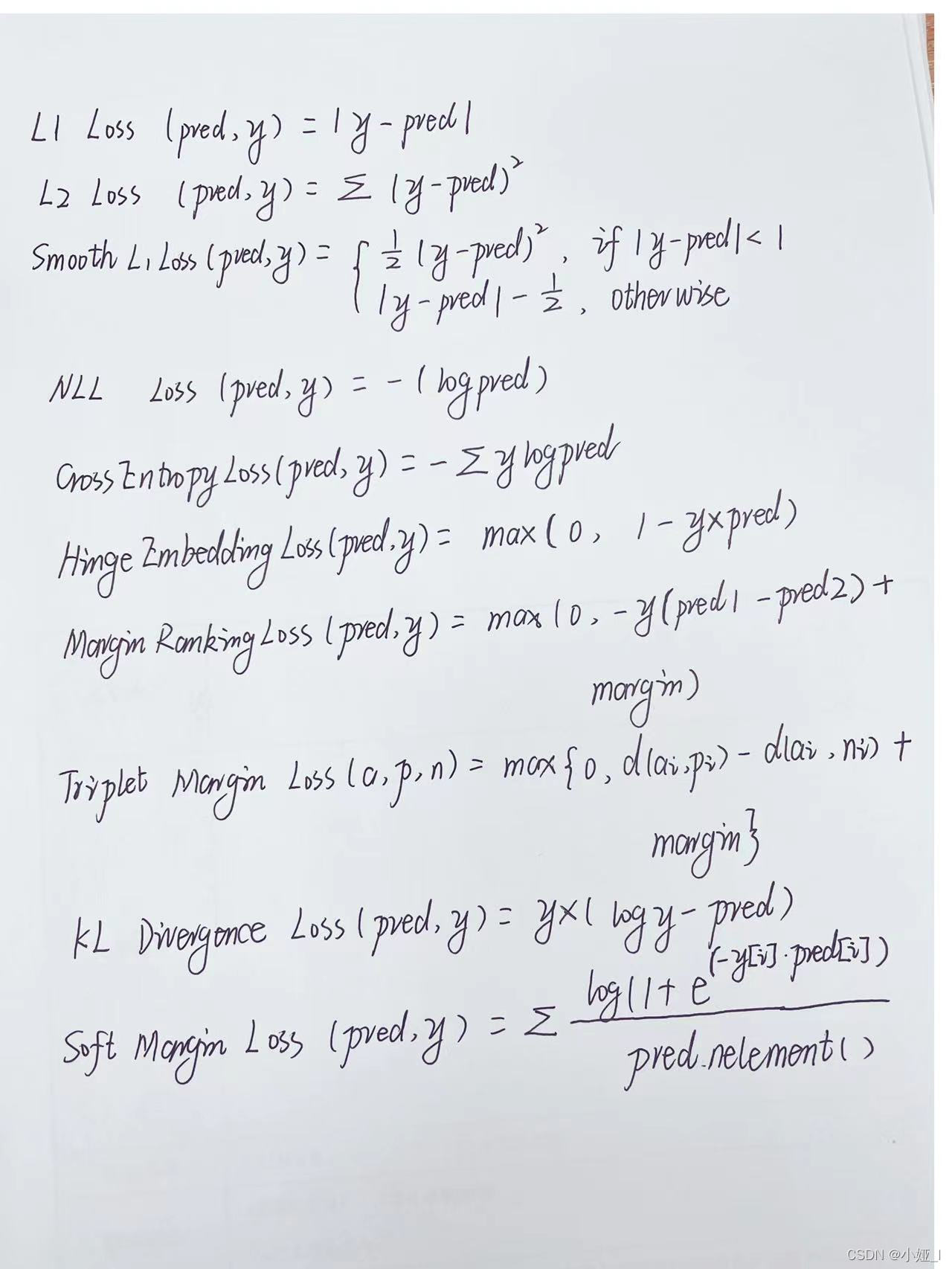前言
损失函数在深度学习中占据着非常重要的作用,选取的正确与否直接关系到模型的好坏。
本文就常用的损失函数做一个通俗易懂的介绍。
一、损失函数
根据深度函数的模型类型,损失函数可分为三类:
1. 回归损失(Regression loss):预测连续的数值,即输出是连续数据:如预测房价、气温等;
2. 分类损失(Classification loss):预测离散的数值,即输出是离散数据:如预测硬币正反、图像分类、语义分割等;
3. 排序损失(Ranking loss):预测输入样本间的相对距离,即输出一般是概率值,如预测两张面部图像是否属于同一个人等;
二、详解
1.回归损失
(1.)L1 Loss 计算实际值与预测值之间的绝对差之和的平均值;
表达式如下:
使用示例:
import torch
import torch.nn as nn
import numpy as np
# L1 Loss
input = torch.randn(2, 2, requires_grad=True)
target = torch.randn(2, 2)
mae_loss = torch.nn.L1Loss()
output = mae_loss(input, target)
# print("input: ", input)
# print("target: ", target)
# print("output: ", output)

(2.) L2 Loss 计算实际值和预测值之间的平方差的平均值;
L2 由于将误差平方化,因此当误差大于1时,整体偏差会被放大,出现极端偏差值时,L2模型会因为惩罚更大而开始偏离较远,相比之下,L1对异常值的鲁棒性更好。
表达式如下:
使用示例:
# L2 Loss
input = torch.randn(2, 2, requires_grad=True)
target = torch.randn(2, 2)
mse_loss = torch.nn.MSELoss()
output = mse_loss(input, target)
# print("input: ", input)
# print("target: ", target)
# print("output: ", output)
(3.)Smooth L1 Loss 计算;(其实可看做L1 和 L2的线性结合)
在实际值与预测值小于1时,选取L2相似计算较稳定,大于1时,L1对异常值的鲁棒性更好,选择了L1的变形计算;
表达式如下:
# Smooth L1 Loss
input = torch.randn(2, 2, requires_grad=True)
target = torch.randn(2, 2)
smooth_l1_loss = torch.nn.SmoothL1Loss()
output = smooth_l1_loss(input, target)
print("input: ", input)
print("target: ", target)
print("output: ", output)

2.分类损失
(1.)NLL Loss(Negative Log-Likelihood) 多分类问题;
# NLL Loss
input = torch.randn(2, 2, requires_grad=True)
target = torch.tensor([1, 0])
m = nn.LogSoftmax(dim=1)
nll_loss = torch.nn.NLLLoss()
output = nll_loss(m(input), target)
print("input: ", input)
print("target: ", target)
print("output: ", output)(5.)Cross-Entropy Loss ,计算实际输出(概率)与期望输出(概率)的距离;(二分类或多分类),可看做nn.LogSoftmax() 和 nn.NLLLoss() 二者的结合;
“NLLLoss 的 输入 是一个对数概率向量和一个目标标签,不计算对数概率. 适合网络的最后一层是log_softmax. 损失函数 nn.CrossEntropyLoss() 与 NLLLoss() 相同, 唯一的不同是nn.CrossEntropyLoss()做 softmax.”
# Cross-Entropy
input = torch.randn(2, 2, requires_grad=True)
target = torch.empty(2, dtype=torch.long).random_(2)
cross_entropy_loss = torch.nn.CrossEntropyLoss()
output = cross_entropy_loss(input, target)
print("input: ", input)
print("target: ", target)
print("output: ", output)

(6.)Hinge Embedding Loss: 判断两个输入是否相似或不同;
# hinge embedding loss
input = torch.randn(3, 3, requires_grad=True)
target = torch.randn(3, 3)
hinge_loss = torch.nn.HingeEmbeddingLoss()
output = hinge_loss(input, target)
print("input: ", input)
print("target: ", target)
print("output: ", output)
(7.)Margin Ranking Loss:预测输入之间的相对距离;
# Margin Ranking Loss
input1 = torch.randn(3, requires_grad=True)
input2 = torch.randn(3, requires_grad=True)
target = torch.randn(3).sign()
ranking_loss = torch.nn.MarginRankingLoss()
output = ranking_loss(input1, input2, target)
print("input1: ", input1)
print("input2: ", input2)
print("target: ", target)
print("output: ", output)(8.)Triplet Margin Loss:计算三元组的损失,确定样本之间的相对相似性;
# triplet margin loss
anchor = torch.randn(5, 5, requires_grad=True)
positive = torch.randn(5, 5, requires_grad=True)
negivate = torch.randn(5, 5, requires_grad=True)
triplet_margin_loss = torch.nn.TripletMarginLoss()
output = triplet_margin_loss(anchor, positive, negivate)(9.)KL Divergence Loss,计算两个概率分布距离;
KL Divergence : 评估概率分布预测与ground truth分布的不同之处;
# KL Divergence Loss
input = torch.randn(3, 3, requires_grad=True)
target = torch.randn(3,3)
kl_loss = torch.nn.KLDivLoss()
output = kl_loss(input, target)
print("input: ", input)
print("target: ", target)
print("output: ", output)(10.) SoftMarginLoss
# Softmargin_loss
input = torch.randn(3, 3, requires_grad=True)
target = torch.randn(3,3)
softmargin_loss = torch.nn.SoftMarginLoss()
output = softmargin_loss(input, target)
print("input: ", input)
print("target: ", target)
print("output: ", output)下图为以上损失函数公式的简单形式:

三. 总结
PyTorch还有很多损失函数,大部分基于这几个类型进行变形和优化,掌握基础是关键!








 本文详细介绍了深度学习中常见的损失函数,包括L1Loss、L2Loss、SmoothL1Loss等回归损失,以及NLLLoss、CrossEntropyLoss、HingeEmbeddingLoss等分类损失。理解这些损失函数对于选择合适的模型和优化训练至关重要。
本文详细介绍了深度学习中常见的损失函数,包括L1Loss、L2Loss、SmoothL1Loss等回归损失,以及NLLLoss、CrossEntropyLoss、HingeEmbeddingLoss等分类损失。理解这些损失函数对于选择合适的模型和优化训练至关重要。
















 1645
1645

 被折叠的 条评论
为什么被折叠?
被折叠的 条评论
为什么被折叠?








